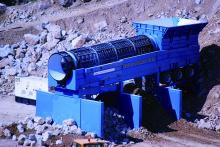
Reuse of overburden normally makes good economic sense but for one UK quarry it has been the subject of a 20 year legal battle. Claire Symes reports
In many quarries overburden stripped to access the rock resource is often stockpiled ready for a later restoration of the site. But in some cases, the amount of overburden is greater than the quantity needed for rehabilitation and is sold on for reuse.
For a few quarries the extent of overburden goes beyond stripping of soil to access the aggregate and is used to define other rock that has to be excavated to access the prime resource. This is the case at Backdale quarry in Derbyshire, UK, where the primary planning permission is for the extraction of fluorspar from the surrounding limestone, which is classed as overburden.
The volume of limestone needed to be extracted to access the fluorspar at Backdale is significant and the quarry has long reprocessed the excess for the local construction market. However, this re-use of the limestone overburden as a resource has been the subject of a 20 year legal battle for land owner Bleaklow Industries.
For the last two decades national park authority Peak District National Park has been challenging the use of the limestone in this way and trying to get the quarry closed down. For Bleaklow owner Rob Harpley, it has been an expensive and time consuming battle through the legal system to operate the site under the terms of the planning permission granted to the site in 1952.
Nonetheless, following a ruling by Justice Sullivan in the appeal court earlier this year, the future of Backdale as an active quarry has finally been settled in favour of Bleaklow.
Few can argue about the beauty of the UK's Peak District in Derbyshire but while its main industry may now be tourism, it has long had links with heavier industries. Quarries and mines to excavate rock and industrial minerals have been recorded in the area for several thousand years and aggregates from the region remain important to the construction and industrial economy.
Like many quarries in Derbyshire, Backdale Quarry's heritage can be traced back to Roman times, when the land was worked for lead. But for the last few hundred years the fluorspar rich veins that rise through the limestone have been the main target of quarrying activity.
"Records show that in 1850 the site at Backdale provided employment for 2500 people," said Harpley. "Back then workers rented an area of ground and mined downwards through the fluorspar vein to great depths using methods that just would not be allowed under modern health and safety regulations." When British Fluorite took over production at the site, it started out just processing the stockpiles of material at the site and at one time supplied the whole of Sheffield with fluorite for smelting.
"Then in 1952 the Town and Country Planning Act came into force and all existing quarries had to apply for permission to continue working," explained Harpley. "At this time, the National Park had already been established with the quarry falling within its boundaries and it was under these conditions that permission for quarrying fluorspar to continue was granted." As work at the site became mechanised and safety regulations improved, it became necessary to extract more of the surrounding limestone to gain safe access to the fluorspar veins.
"In 1988 the Peak District National Park objected to our extraction of limestone at the site but did not place a stop order on the site," said Harpley. "Because of the way the fluorspar veins are orientated at the site, more limestone has to be extracted than fluorspar, by definition." In 1995, the site came under the Review of Old Mineral Permissions (ROMP) which meant that quarries operating under historic planning permissions had to modernise their environment operation. For quarries like Backdale, this meant producing an Environmental Impact Assessment and developing a restoration plan.
It was at this point that the park took more decisive action against the quarrying of limestone at Backdale. "Peak District National Park said that it didn't agree with our interpretation of the planning permission," said Harpley. "To try and avoid a legal deadlock, we appointed a QC and asked to consult with the park's QC to get a clearer understanding of the problem but it refused. Our next step was to ask for declarity relief where both QCs present their opinions to a judge who then rules on the decision but this was also refused by the park.
"Instead they based the determination on their opinion, which involved replacing the limestone after the fluorspar had been extracted. This meant the site was economically unviable and our tenant withdrew from the quarry." Bleaklow then pushed for judicial review of the decision, which concluded that the park's determination was so unreasonable as to be unlawful and Peak District National Park was ordered to pay costs. Harpley would not be drawn on the legal bill faced by the park but suggested that it was sizeable.
Despite the decision, Peak Park further delayed reopening of quarry by calling for more EIA information, a hydrogeology report and traffic assessment on the site.
"Just when I thought we'd climbed the final hurdles, the park entered into an agreement with an adjacent land owner to exchange the land for another quarry site outside the park area," said Harpley. "The arrangement effectively sterilised the quarry and made it impossible for us to put the restoration plan into action but we were also limited by the need to make a living so continued quarrying." There then followed an enforcement and stop notice from Peak District National Park for Backdale and two public inquiries - the notice for the first was declared legally null because the stop notice did not state the problem or how it could be resolved.
The planning inspector overseeing the second inquiry did not accept either Bleaklow's or the Peak District National Park's interpretation of the original planning permission. "He ruled that since the primary planning permission was for the extraction of fluorspar and lead, then this was the primary purpose but if extraction of limestone allowed for more work on the primary purpose, then it should be permitted. He decided that for every tonne of fluorspar, 2tonnes of limestone could be extracted," said Harpley.
"However, since the ratio of limestone to fluorspar is highly variable, the ruling still made it difficult to operate Backdale, so we took the issue to the appeal court." It is this decision which Justice Sullivan ruled on in March this year. In his statement he declared the planning inspector's decision "demonstrably unworkable" and sided with Bleaklow's determination of the planning consent. He added that Bleaklow and its tenant Merrimans had suffered "manifest procedural unfairness" and the decisions of the planning inspector at the public inquiry were "fundamentally flawed" because the 2:1 ratio was not made based on the geology but an arbitrary figure.
"In his summing up the appeal judge said he didn't see how the planning inspector could interpret the permission in such a way that frustrated it rather than facilitated it," said Harpley.
Enforcement and stop notices were then withdrawn for Backdale, and neighbouring Wagers Flat which also operates under the same planning consent. Bleaklow's tenant, Merrimans, is now actively working both the limestone overburden and the fluorspar veins at Backdale.
Nonetheless, despite facing large legal bills, and the potential of compensation claims from Merrimans, Peak District National Park has vowed to appeal the decision of the Appeal Courts.








